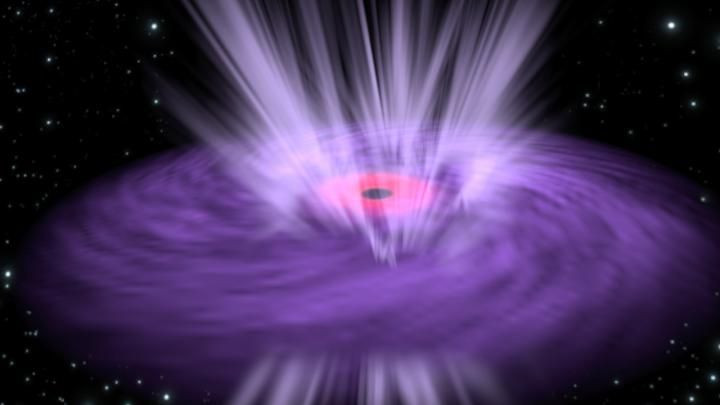Astronomers Spy A Distant Supermassive Black Hole Choking On Stardust

Black holes are often defined as the universe’s vacuum cleaners. Although the analogy is scientifically incorrect and flawed, it is easy to imagine why it originated and continues to persist — these mysterious bodies, formed as a result of a massive star collapsing in on itself, are so dense, that nothing, not even light can escape their gravitational pull.
Occasionally, their greed and voracious appetites get the better of them. Case in point — a supermassive black hole located in a galaxy 300 million light-years from Earth, which has been observed “choking” on its food.
Read: Our Black Hole Has Been 'Eating Snacks' For The Last 6 Million Years
The observations, made using a global network of robotic telescopes named ASASSN (All Sky Automated Survey for SuperNovae), were described in a study published Wednesday in the Astrophysical Journal Letters.
Specifically, what the scientists observed was a “tidal disruption” event.
When an object has the misfortune of getting trapped in a black hole’s gravitational well, massive tidal forces acting on it stretch it vertically through a process known as “spaghettification” — a process that culminates in an enormous burst of high-energy radiation as the object is swallowed by the black hole. Although these events are extremely energetic, in the cosmic scale of things, they are located too far and occur too infrequently for Earth-based scientists to observe.
“You’d have to stare at one galaxy for roughly 10,000 to 100,000 years to see a star getting disrupted by the black hole at the center,” study lead author Dheeraj Pasham from the Massachusetts Institute of Technology's Kavli Institute for Astrophysics and Space Research said in a statement.
In this case, though, the researchers lucked out. The tidal disruption flare from this distant black hole was first discovered on Nov. 11, 2014, and subsequent observations using a variety of telescopes have revealed curious pattern in the energy being emitted. Not only did the researches detect small fluctuations in the optical and ultraviolet bands of the electromagnetic spectrum, the pattern was found to repeat 32 days later in the X-ray band.
According to the researchers, this pattern is the result of stellar debris colliding with itself (which produces bursts of optical and UV light), and heating up just before being swallowed by the black hole (which gives off X-ray flares).
Read: Scientists Simulate Accretion Disk Flow Around Sagittarius A*
“In essence, this black hole has not had much to feed on for a while, and suddenly along comes an unlucky star full of matter,” Pasham said. “What we’re seeing is, this stellar material is not just continuously being fed onto the black hole, but it’s interacting with itself — stopping and going, stopping and going. This is telling us that the black hole is ‘choking’ on this sudden supply of stellar debris.”
Researchers hope that further observations of the black hole could shed light not only on how these bodies feed, but also on the exact location where the X-ray and optical emissions arise from.
“Because you have a lot of material falling on to the black hole, it’s interacting with itself, falling in again, and interacting again. If there are more events in the future, maybe we can see if this is what happens for other tidal disruption flares,” Pasham said in the statement.
© Copyright IBTimes 2024. All rights reserved.






















